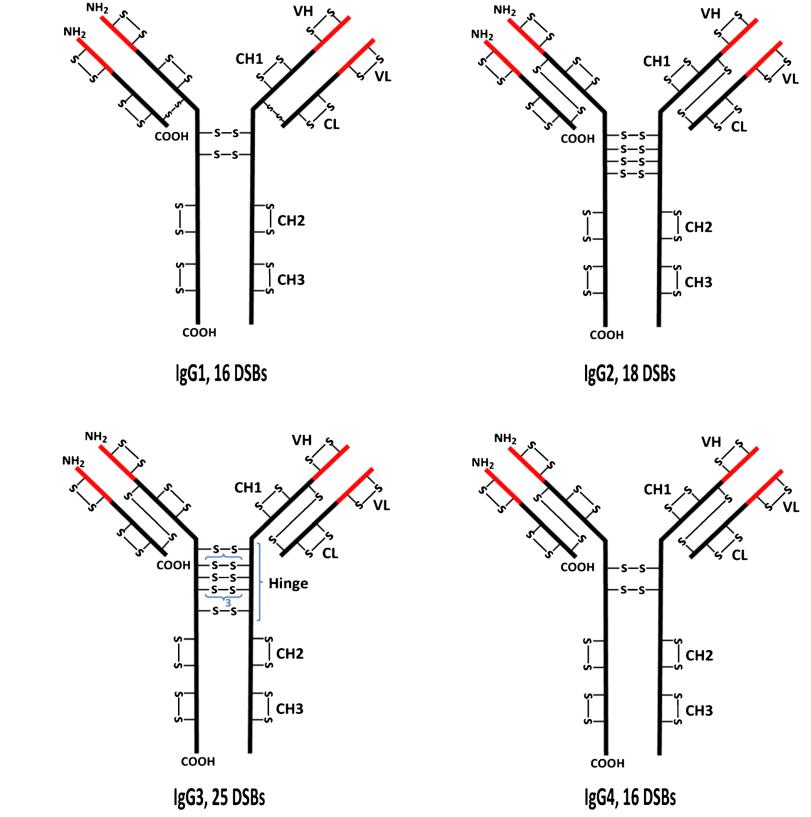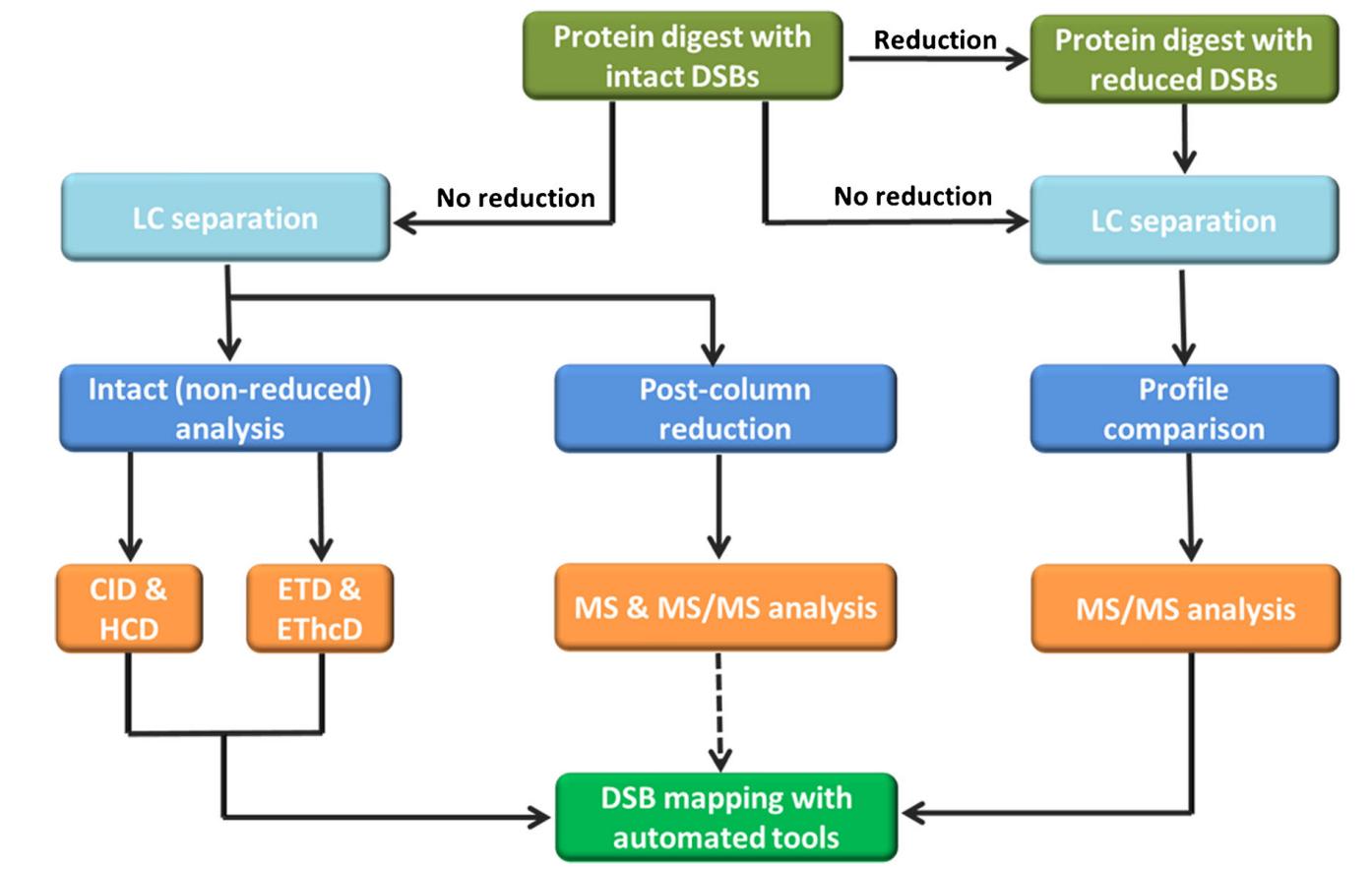Antibody drugs are an important class of biologics. Their higher-order structures and therefore their functions are fundamentally determined by the correct formation of disulfide bonds (DSBs), making DSB analysis a central part of their development and production. However, disulfide bond analysis is challenging due to the complexity of biomolecules. Creative Proteomics provides our clients with mass spectrometry-based analytical tools to accurately obtain disulfide bond localization information. Our experienced scientists combine peptide spectroscopy data with specialized software to analyze the data and help you with structural analysis, molecular design, property modification and process studies of antibody drugs.
Importance of Disulfide Bond Analysis for Antibody Drugs
Disulfide bonds (S-S bonds) are formed through the oxidation of sulfhydryl groups (-SH) on two cysteines in proteins and are an important form of post-translational modification of proteins. It ensures proper folding, provides stability and ensures proper function. Especially with highly disulfide-bonded monoclonal antibodies, the disulfide bond arrangement is a reflection of the structural properties of the drug. Therefore, confirming proper disulfide bond attachment and verifying the presence of disulfide bond variants in an antibody drug can help ensure drug safety and efficacy.
 Fig 1. Structures showing the typical disulfide bond (DSB) patterns of the four classes of IgG antibodies. (Lakbub, J. C., et al, 2018)
Fig 1. Structures showing the typical disulfide bond (DSB) patterns of the four classes of IgG antibodies. (Lakbub, J. C., et al, 2018)
Disulfide Bond Analysis Services at Creative Proteomics
Mass spectrometry (MS) has long been our analytical tool of choice for characterizing such complex biomolecules. Creative Proteomics offers the latest in MS technology and provides important considerations needed for the analysis of effective disulfide bonds in proteins. Combined with years of experimental experience, we offer high quality solutions for disulfide bond analysis of antibody drugs, including proper sample preparation, fragmentation techniques for disulfide bond analysis, state-of-the-art disulfide bond mapping methods based on fragmentation techniques, and automated algorithms for rapid analysis of disulfide bonds in LC-MS/MS data. Our disulfide bond analysis services can help clients meet the following detection demands:
- Realizing the identification of disulfide bond number and free sulfur groups in protein drugs.
- Identification of Disulfide Bond Positions in Protein Drugs.
Bottom-up MS Analytical Method for Disulfide Bond Characterization at Creative Proteomics
Creative Proteomics is acutely aware that the comprehensive characterization of disulfide bond formation in antibody drugs cannot be solved by a single technique alone. With the advent of MS, liquid chromatographic-mass spectrometric and liquid chromatographic-tandem mass spectrometric methods have become the go-to methods for disulfide bond mapping in proteins. Among them, bottom-up mass spectrometry is our most widely used method for disulfide bond analysis. The attractive aspects of the bottom-up approach to mass spectrometry that we offer include:
- The availability of a variety of enzymes to digest the large biomolecules into small pieces (peptides containing intact disulfide bonds) that are easier to analyze.
- Several soft ionization techniques, complementary fragmentation techniques, and the ability to couple mass spectrometers with LC systems for separation of the enzymatic digests before mass spectrometric analysis.
 Fig. 2 Bottom-up approaches for disulfide bond (DSB) analysis. (Lakbub, J. C., et al, 2018)
Fig. 2 Bottom-up approaches for disulfide bond (DSB) analysis. (Lakbub, J. C., et al, 2018)
Our characterization experts understand the important considerations required for the analysis of effective disulfide bonds in antibody drugs, including methods for proper sample preparation, fragmentation techniques for disulfide bond analysis, state-of-the-art disulfide bond mapping methods based on fragmentation techniques, and automated algorithms for the rapid analysis of disulfide bonds in LC-MS/MS data. Our top-down analytical strategy allows for a comprehensive characterization of disulfide bond-related information in antibody drugs.
What We Deliver?
| Related Mass Spectrometer Parameters |
Mass Spectra |
| Raw data |
Protein disulfide bond attachment site information and free cysteine ratio |
One-Stop Analysis Process at Creative Proteomics
Creative Proteomics is committed to providing one-stop disulfide bond analysis services using our high-throughput and high-sensitivity analytical technologies. All you need to do is to submit your samples to us and our scientists will work closely with you to deliver the final results in a short period of time. Our one-stop analytical process consists of the following steps:
- Sample preparation prior to disulfide bond analysis.
- Various digestion methods are available according to the needs of sample analysis.
- Separation of protein digests.
- Analysis of disulfide bonds using a bottom-up MS method.
- Report generation and results delivery
Creative Proteomics provides our clients with authentic, reliable and timely characterization analysis with our advanced technology platform. Contact us to learn more about our disulfide bond analysis services. We will be happy to assist you.
Reference
- Lakbub, J. C.; et al. Recent mass spectrometry-based techniques and considerations for disulfide bond characterization in proteins. Analytical and bioanalytical chemistry. 2018, 410: 2467-2484.

 Fig 1. Structures showing the typical disulfide bond (DSB) patterns of the four classes of IgG antibodies. (Lakbub, J. C., et al, 2018)
Fig 1. Structures showing the typical disulfide bond (DSB) patterns of the four classes of IgG antibodies. (Lakbub, J. C., et al, 2018) Fig. 2 Bottom-up approaches for disulfide bond (DSB) analysis. (Lakbub, J. C., et al, 2018)
Fig. 2 Bottom-up approaches for disulfide bond (DSB) analysis. (Lakbub, J. C., et al, 2018)